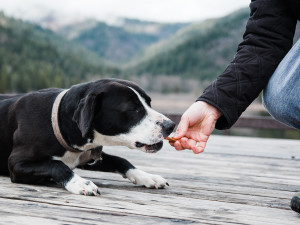Are Chicken Feet Good for Dogs or Harmful to Their Health?
Just because your pup will eat anything doesn’t mean it’s good for them.
In This Article:
What Are Chicken Feet? Nutritional Benefits of Chicken Feet Potential Risks of Feeding Chicken Feet to Dogs Should You Feed Your Dog Chicken Feet? Is Raw or Cooked Chicken Feet Best? How to Safely Prepare Chicken Feet for Your Dog
Chicken feet have become a popular addition to the arsenal of dog chews and treats, especially in pet shops and among pet parents who champion raw food. There are a few reasons why. They’re cheap, consist of a single ingredient, and look like a natural method of supporting joint and dental healthopens in new tab.
However, before feeding your pup something new, make sure it’s safe. As far as chicken feet go, there are indeed some risks alongside benefits. This article will explain what chicken feet are, their nutritional value, the pros and cons of feeding them to your pup, and whether they belong in your pet’s bowl or not.
What are chicken feet?
Chicken feet are just what they sound like. They consist of the lower leg and foot of a chicken, complete with skin, tendons, ligaments, small bones, and nails/claws. They are prepared in a few different ways:
How much do you spend on your pet per year?
Raw (fresh or frozen)
Air-dried or dehydrated
Freeze-dried
Smoked or baked
The main composition of chicken feet is skin and connective tissue with small bones. That matters: Skin and connective tissues are rich in collagen, while bones are made of calcium-phosphate. The claws are keratin.
Nutritional benefits of chicken feet
We’ve already mentioned joint and dental advantages, above. But there are even more advantages. Chicken feet can be a high-value, single-ingredient treat that delivers collagen and a bit of joint-supporting cartilage. Think “supplementary treat,” not “meal.”
Collagen and gelatin: The skin and connective tissues supply collagen, which provides amino acids such as glycine and proline that support joint cartilage, skin, and the gut lining. A balanced diet for dogs can be supplemented with collagen to aid in arthritisopens in new tab treatment.
Joint support: The cartilage in chicken feet contains glucosamine and chondroitin, which help maintain joint cartilage in your dog. The amounts vary and are not standardized as they are in supplements.
Chewing enrichment: Mental stimulation is vital to our pets. Chicken feet offer a crunchy or chewy texture that provides mental stimulation and satisfies the chewing instinct. Calmer minds result from busy mouths.
Potential dental abrasion: Chicken feet are not a replacement for toothbrushing or professional cleanings, but their crunchiness may help decrease soft plaque on teeth by mechanical abrasion. This can be a small part of a dental-care routine for certain dogs.
Minerals: The essential minerals, calcium and phosphorus, are provided by the small bones in chicken feet. Given in tiny, occasional amounts, this can be beneficial.
Potential risks of feeding chicken feet to your dog
Unfortunately, the same characteristics that make chicken feet desirable can also create dangers.
Choking and obstruction
Feet contain multiple small bones. If a dog chews them thoroughly, all is well. However, some dogs chew less and swallow more, including large pieces of bone — and they can choke on them. Enthusiastic, fast eaters and small dogs are more prone to this.
Bone injury
Depending on the processing method, cooked bones can become brittle and splinter. This happens with some dehydrated products: Certain dry methods result in crumbles, while others result in cooked bones. Oral injuries, esophageal damage, or intestinal perforation can potentially occur.
Foodborne pathogens
If chicken feet are served raw, your dog can be exposed to Salmonella or Campylobacter. Often, healthy dogs are not affected by this, but immunocompromised dogs can get an infection. The people in the home who handle the chicken feet can also be at risk. Use strict hygiene.
Fat and calorie load
Dogs with a history of pancreatitis, obesity, or hyperlipidemia should not be fed chicken feet due to the fat contained in the skin. Air-dried feet are usually leaner than raw.
Sodium or additives
Smoked or seasoned feet can be high in sodium and may contain preservatives or flavorings that are not good for dogs. Stick to plain, single-ingredient products.
Allergies and intolerances
Obviously, chicken feet are not an option if your dog is allergic to chicken. Watch for itching, ear infections, or GI upset.
Dental concerns
Puppies with baby teeth, seniors with dental disease, or any dog with worn, fractured, or sensitive teeth may find dried feet uncomfortable or damaging.
Who should avoid them entirely?
Dogs with a history of pancreatitis, significant dental disease, GI strictures, gastrointestinal surgery, megaesophagus, or a chicken allergy should avoid chicken feet. Meanwhile, dogs who are notorious gulpers and households with high human food-safety concerns should take a pass as well.
Should you feed your dog chicken feet?
Here’s how to decide.
If you have a healthy adult dog with calm eating habits who is a good chewer, chicken feet can be an occasional treat.
Conversely, if you have a puppy, a senior with dental disease, or a gulper, they are at higher risk. Consult your vet about soft dental chews that may be safer.
Does your dog have pancreatitisopens in new tab, GI disease, or a chicken allergy? Do not feed them chicken feet.
If there are dogs or humans in the home who are immunocompromised, it is safest to avoid raw chicken feet.
Portion guidance (general). Treats should make up less than 10 percent of a dog’s daily calories. Here’s some context, based on a dog’s size:
Under 20 pounds (nine kilograms): Half a small foot, no more than one to two times weekly
20 to 50 pounds (nine to 23 kilograms): One small foot, one to two times weekly
Over 50 pounds (23 or more kilograms): One standard foot, up to two times weekly
Be sure to adjust the amount you give your dog based on their fat tolerance, stool quality, and your vet’s advice. Always supervise them as they eat.
Are raw or cooked chicken feet best?
Never feed your dog boiled, roasted, or otherwise cooked chicken feet because they can result in brittle bones that splinter.
No animal bone is 100 percent safe. But there are some safer options.
Freeze-dried or air-dried feet (plain) are safer than raw when it comes to bacteria, shelf-stable, and tend to crunch rather than shred when chewed. Choose reputable brands with quality control and no added salt or smoke.
Pet parents who are experienced at practicing meticulous hygiene and are very familiar with their dog’s chewing style can try raw feet from a trusted source. Freeze first to avoid parasites, and handle like raw poultry.
Smoked feet are not recommended due to their high sodium content and brittleness.
How to safely prepare chicken feet for your dog
If your veterinarian agrees that it’s OK for your dog to try chicken feet, lower the risk by following these safety measures.
Select plain, single-ingredient, freeze-dried, or air-dried feet from a reputable manufacturer. Avoid seasoned, smoked, or brined products.
Check for sharp claws. Use kitchen shears to trim the tips to reduce the risk of scratches to the mouth or GI tract.
Match foot size to your dog’s size. (See our previous chart.) If you have a toy breed, you may want to skip chicken feet altogether.
Monitor closely. If your dog tries to swallow large chunks, remove the foot.
Offer a tiny amount the first time, and monitor for 48 hours for vomiting, diarrhea, constipation, or lethargy.
Keep raw feet frozen until use. Thaw in the refrigerator, and treat surfaces and bowls as you would for raw chicken prep.
Store freeze-dried or air-dried feet in an airtight container in a cool, dry place.
Don’t forget that chicken feet are not a meal. Give them as a treat. Monitor the total calories and calcium.
Signs to stop at once and seek vet care. These may indicate obstruction or injury.
Gagging
Repeated vomiting
Unproductive retching
Abdominal pain
Blood in stool
Lethargy after ingestion
As with any new chew or supplement, the safest approach is to consult your veterinarian about your dog’s health status, diet, and risk factors. For many dogs, an occasional, well-chosen chicken foot is a fine, high-value treat. For others, there are safer alternativesopens in new tab (soft dental chews, rubber chew toys, or vet-recommended joint supplements) that offer similar benefits with fewer risks.
Bottom line
Chicken feet can be a natural, useful chew for healthy dogs with good teeth and proper chewing habits. They supply collagen, and the bones in them provide small amounts of cartilage, which supports joints. However, small bones can cause choking, obstruction, or injury if the dog does not chew thoroughly or if the bones are cooked or brittle.
Feeding your dog raw chicken feet comes with a risk of bacterial contamination for dogs and the people handling them. Smoked or seasoned feet are not good options, because they provide too much sodium and are exceedingly processed. Choose plain, freeze-dried, or air-dried from reputable brands, trimming claws and starting with small portions. Avoid chicken feet entirely if your dog has pancreatitis, GI disease, dental problems, a chicken allergy, a history of gulping or obstructions, or if household food-safety concerns make raw handling impractical.
References
ARAÚJO, Íris Braz da Silva, et al. “Optimal Conditions for Obtaining Collagen from Chicken Feet and Its Characterization.” Food Science and Technology, vol. 38, no. suppl 1, Dec. 2018, pp. 167–173, doi.org/10.1590/fst.27517opens in new tab.
“Physicochemical Properties of Hydrolyzed Collagen Produced from Chicken Feet.” Middle East Journal of Agriculture Research, 2020, doi.org/10.36632/mejar/2020.9.1.8opens in new tab.
Santana, José C. C., et al. “Valorization of Chicken Feet By-Product of the Poultry Industry: High Qualities of Gelatin and Biofilm from Extraction of Collagen.” Polymers, vol. 12, no. 3, 2 Mar. 2020, p. 529, doi.org/10.3390/polym12030529opens in new tab.








